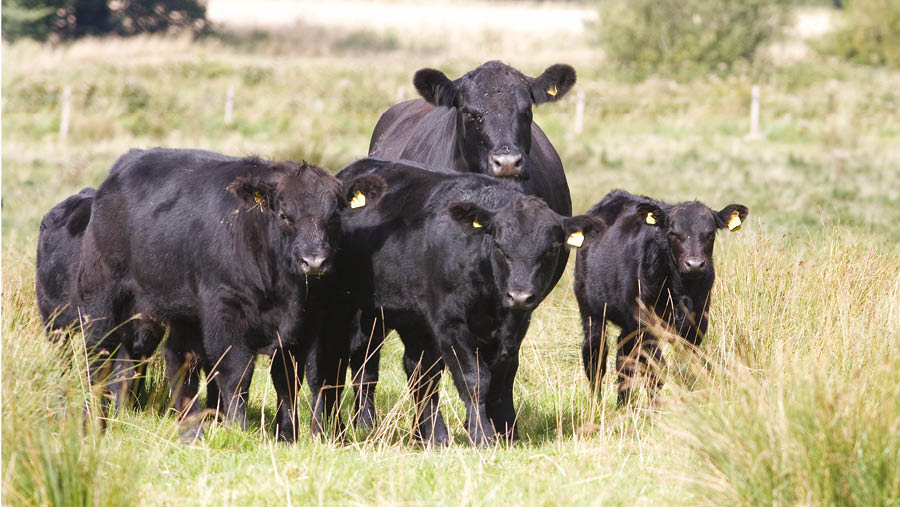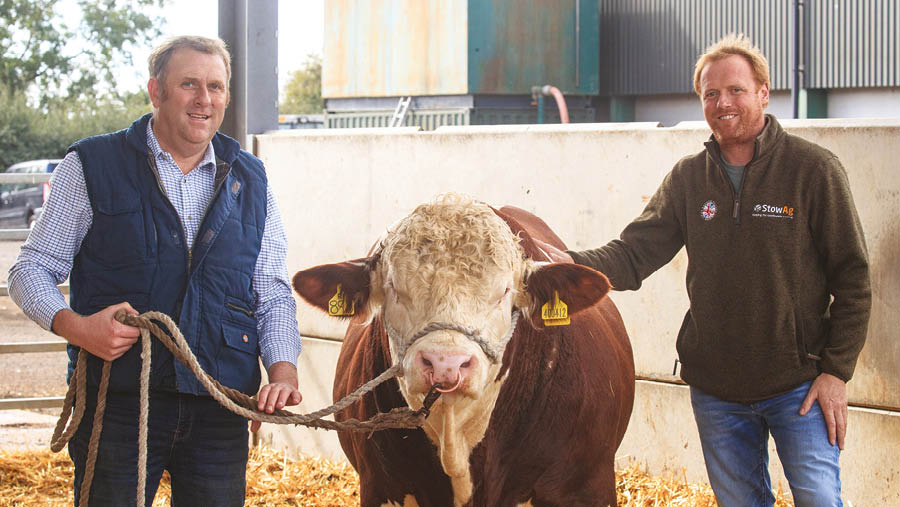Why clear identification of polled genetics is needed
 © Tim Scrivener
© Tim Scrivener Disbudding calves is a challenging and expensive job and, as herds scale up and calving patterns tighten, it can put huge financial and time pressure on beef farmers.
But, while many are keen to eliminate the need for disbudding by selecting bulls guaranteed to produce only polled calves, identifying those genes is far from straightforward.
This is because breed societies do not use a common identification system, says beef specialist Basil Lowman of SAC Consulting.
See also: Advice for reducing reliance on soya in suckler beef systems
He insists this must change; if not, the industry risks compulsory regulation on polling as a result of pressure from consumers on meat buyers.
He points to recent changes to dairy bull calf euthanasia, with milk buyers requiring their suppliers to rear these animals for a minimum period of time.
“Disbudding in a beef situation is much more risky than in a dairy system because the suckling calf must be separated from its mother [during the procedure].
“Try taking a baby calf off its mother – it is dangerous,” he says.
“We are at the stage where commercial breeders are getting worried about using horned genetics because herds are getting bigger.
“It is not uncommon now to have a beef herd of 200 animals, even 500, which means disbudding all their calves over just a two-month period.”
Call for united action
Mr Lowman is calling for a single system, easily understood by beef farmers, to identify the two different types of polled bull. And he wants the industry to unite to deliver this.
At present, how the polled status of bulls is shown at sales depends on the breed.
“I don’t believe there is a breed society that is taking care of its potential buyers and insisting that the full genetic status of the polled bull is declared at society sales,” says Mr Lowman.
“Some only identify bulls that are polled by the letter P displayed as a capital letter after the bull’s name in the sale catalogue.”
Polled and horned genes
This creates a risk for buyers because polling in cattle is controlled by two genes. If an animal is born with one polled and one horned gene, or with two polled genes, it will be polled.
A bull with two polled genes is referred to as homozygous, while one with one horned gene and one polled gene is known as heterozygous.
The heterozygous bull will be born polled because this is the dominant gene. Yet when this bull is used on horned cows, only about half of his calves will be polled.
“This means that all of his progeny will still have to be checked for signs of a horn bud,” says Mr Lowman.
The confusion in identifying the exact genetic combination of genes, he suggests, is significantly delaying the development of a polled UK beef herd.
Progress
Some breed societies are making progress. The British Simmental Cattle Society included a guide to polling and its terminology in its Stirling Simmental Sale catalogue this year.
“This is very much a first and important step in helping buyers at sales around the subject of polled [genetics],” says its general manager, Iain Kerr.
Proposed polling identification system
Beef specialist Basil Lowman of SAC Consulting is proposing the following universal identification system:
- P (capital letter) = polled gene
- h (lower-case) = horned gene
- PP = homozygous polled bull
- Ph = heterozygous polled bull
As all the calves sired by a PP bull would be polled, it would be justifiable for a breeder to charge a significant premium above their genetic value because the need, cost and danger of disbudding would be eliminated, says Mr Lowman.
“I have a lot of sympathy for farmers, and the biggest help we can give them is to have the two types of polled genetics clearly identifiable, in one common language.”
To drive change, he advises buyers to always ask the seller whether the bull is homozygous or heterozygous.
“If it hasn’t been tested, so the buyer doesn’t know, don’t buy it. It is the only way things will change, although polling isn’t the only consideration – everything else has to be right too,” he says.
“A lot of breeders test genomically for double muscling – why not add polling to that list?”
Case study: Hall Farm, Rugby

James and Andrew Barnes g British Simmental Cattle Society
Farm Facts
- 324ha (800 acres)
- 150-cow herd of pedigree polled Simmentals
- February-March calving, with herd then out at grass until November
- Breeding animals reared on silage-based total mixed ration
- Bulls destined for slaughter grown on a more intensive ration to finish at 12-14 months at average 400-420kg deadweight and graded at mostly R+ and U+
Some breeders have already made the move towards a fully homozygous polled herd.
Brothers Andrew and James Barnes, of the Highcross Simmental herd, had been producing beef from a variety of breeds in a commercial system at Hall Farm, near Rugby, before they bought most of the Lopemede Simmental herd in 2018.
That herd, bred by John Rixon, was one of the first and largest polled Simmental herds in the country, developed by sourcing polled genetics from Denmark and slowly progressing the herd in that direction.
With those cows, and five stock bulls also acquired from Mr Rixon, the Barneses have now developed a pedigree polled Simmental herd.
All bulls used in the system are DNA-tested to ensure they have the correct polling genes.
Saving time
Andrew says eliminating the job of dehorning has many advantages. “It is a time saving of at least 10 minutes a calf and it removes the stress from the animals and people.
“After the calf is born, all we have to do is put an ear tag in, jot down its sex and weight, that’s it.”
Although the herd is pedigree, it is run to commercial principles. Heifers are bulled at 15 months to calve at two years.
All cows are served naturally, with the ratio of cows to a bull varying according to the size of paddock, but mostly about 35 cows to a senior bull and 25-26 to a junior bull.
The best heifer calves are kept as replacements and others sold for breeding or fattened. Bulls are selected according to their potential.
“We select more than we are likely to sell and those that don’t make the grade are fattened,” Andrew explains.
Carcass quality
Some of the cows in the Highcross herd are polled going back many generations.
Andrew says there is misconception that a polled animal produces an inferior carcass, and that needs to change.
There can still be a stigma attached to polled bulls and it can be difficult for some beef farmers to see beyond that, he says.
“If you can produce the same quality calf, slaughtered at the same age, why would you choose to produce an animal that you have to dehorn?
“I have never met anyone who is using polled bulls who would ever go back to dehorning,” he says.
